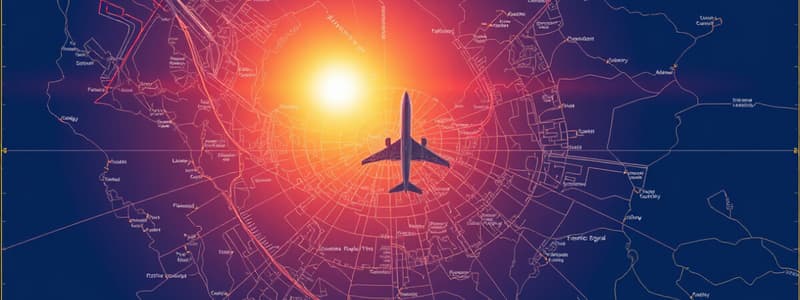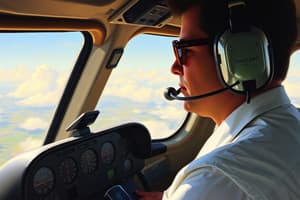Podcast
Questions and Answers
What type of airport is indicated by a blue or green symbol?
What type of airport is indicated by a blue or green symbol?
- Military Airport
- Civil Airport (correct)
- Private Airport
- None of the above
Brown airports have Instrument Approach Procedures (IAPs).
Brown airports have Instrument Approach Procedures (IAPs).
False (B)
What is the significance of a solid line box around an airport name?
What is the significance of a solid line box around an airport name?
It indicates FAR 93 Special Requirements.
What does 'NO SVFR' signify above an airport name?
What does 'NO SVFR' signify above an airport name?
What does 'VOR' stand for?
What does 'VOR' stand for?
What information does DME provide?
What information does DME provide?
What does TACAN stand for?
What does TACAN stand for?
What does an underlined voice communication indicate in NAVAID?
What does an underlined voice communication indicate in NAVAID?
The abbreviation ASOS stands for __________.
The abbreviation ASOS stands for __________.
What does RCO stand for in aviation terms?
What does RCO stand for in aviation terms?
The frequency protection usable range at 18,000' AGL is __________.
The frequency protection usable range at 18,000' AGL is __________.
Flashcards are hidden until you start studying
Study Notes
Airport Symbols
- Civil Airport: Blue or green symbols indicate Instrument Approach Procedures (IAPs); brown symbols do not.
- Military Airport: Similar color coding as civil airports for IAPs.
Airport Details
- Airport Elevation: Specified in feet above or below mean sea level.
- Private Use Airports: Marked as "Pvt," indicating limited accessibility.
- FAR 93 Special Requirements: Indicated by a solid line box around the airport name; refer to directory for details.
- No SVFR: Prohibits fixed-wing special VFR flights; indicated above the airport name.
- Class C/D Airspace Symbol: Class C represented by a "C" in a square; Class D by a "D" in a square, following the airport identifier.
Lighting Availability
- Pilot Controlled Lighting: Facilities with controllable lights are indicated.
- Lighting Capability: A top star indicates part-time or on-request lighting; no star means no lighting available.
Navigation Aids
- VOR (VHF Omnidirectional Range): Filled-in symbols represent compulsory reporting points.
- VOR/DME: Similar to VOR, with DME for distance measuring; also indicates compulsory reporting.
- TACAN (TACtical Air Navigation): Military navigation system offering higher accuracy than VOR.
- VORTAC: Combines VOR and TACAN capabilities; military uses TACAN exclusively.
- DME: Distance Measuring Equipment; filled-in for compulsory reporting.
- NDB (Non-Directional Beacon): Also filled-in for compulsory reporting, providing guidance.
- NDB/DME: Combines features of both NDB and DME for navigation.
Communication and Frequency Information
- Communication Boxes: Include RCO frequencies, NAVAID name, frequency identifiers, coordinates, and controlling FSS name.
- RCO Frequencies: Indicate single frequency use or multiple frequencies depending on the context; "R" is receive-only, "T" is transmit-only.
- Thin Line NAVAID Boxes: Signify no available frequencies for a NAVAID; shadow boxes denote matching names between NAVAIDs and Flight Service Stations.
Frequency Protection
- Usable Range: At 18,000' AGL, usable range is 40 NM; at 12,000' AGL, it’s 25 NM.
Distance Measuring Equipment
- DME Facilities: Operate in "Y" mode for DME reception.
Voice Communications
- Voice Transmissions: Indicated by underlined text; if underlined, no voice transmitted.
NAVAID Shutdown Status
- Shutdown Status: Relevant information on NAVAID operational status.
Part-time Services
- On-Request Services: Highlight operational flexibility and availability.
Automated Weather Services
- ASOS/AWOS: ASOS is a National Weather Service owned system providing current weather, while AWOS is typically airport-owned with similar functionalities.
- HIWAS: Continuous broadcast of hazardous weather info over selected VORs; includes airmets, sigmets, and urgent PIREPs.
- TWEB: Transcribed Weather Broadcast service for additional weather information.
Geographical Coordinates
- Latitude and Longitude: Provided for NAVAIDs involved in airways or holding patterns.
VOR Detailed Information
- VOR Communication: Example shows receive only frequency of 122.1R; includes controlling FSS information and service volumes.
Studying That Suits You
Use AI to generate personalized quizzes and flashcards to suit your learning preferences.




